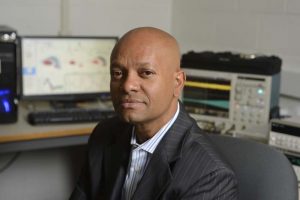 Speaker: Ralph Etienne-Cummings, Professor and Chair of Electrical and Computer Engineering at Johns Hopkins University
Speaker: Ralph Etienne-Cummings, Professor and Chair of Electrical and Computer Engineering at Johns Hopkins University
Title: Hardware Compressive Sampling: Communicating Videos over Narrow Data Pipes
Abstract: Mobile wireless sensor nodes (MWSN) mounted with low power CMOS video cameras (CVC) have been utilized for surveillance, emergency management and monitoring of hazardous areas [1]. These nodes are integral parts of Internet-of-Everything as they are the “eyes” of the network to interact with the world. Due to physical constraints, CVC mounted on MWSN must be small and low power. It also needs to provide videos with high spatial (high pixel counts, good SNR) and temporal resolution (high framerate, low motion blur) when the scene is changing under different lighting conditions. These specifications are often difficult to satisfy simultaneously with conventional sensors: Capturing a scene with high framerate increases readout (RO) power consumption. Additionally, high frame rate also limits pixel exposure time which degrades scene contrast and SNR. We present a CVC chip to achieve these specifications simultaneously. To reduce RO speed while guarantee high frame rate, the imager is designed with Compressed Sensing (CS) based Pixel-wise coded exposure (PCE) techniques. We demonstrate the advantage of PCE over conventional imager is that pixel exposure interval is no longer defined by the framerate. The pixel exposure interval can span multiple frames to enhance SNR without inducing motion blur to the recovered video. Our CVC is the first CMOS implementation of PCE. Further, we report a complete single chip that includes an APS array with spatiotemporal compressive sampling circuits and wireless transmission using an Ultra-Wide Band (UWB) transmitter (TX). Lastly, we generalize this approach for other data collection and low power transmission applications, such as in wireless neural recording.
Bio: Ralph Etienne-Cummings, an IEEE and Kavli Frontiers Fellow, received his B. Sc. in physics, 1988, from Lincoln University, Pennsylvania. He completed his M.S.E.E. and Ph.D. in electrical engineering at the University of Pennsylvania in December 1991 and 1994, respectively. Currently, Dr. Etienne-Cummings is a professor of electrical and computer engineering, and computer science at Johns Hopkins University (JHU). He is the current Chairman of the Electrical and Computer Engineering Department at JHU. He was the founding Director of the Institute of Neuromorphic Engineering (INE), and currently serves Treasurer of the INE. He was also the Associate Director for Education and Outreach of the National Science Foundation (NSF) sponsored Engineering Research Centers on Computer Integrated Surgical Systems and Technology at JHU. He has served as Chairman of the IEEE Circuits and Systems (CAS) Technical Committee on Sensory Systems and on Neural Systems and Application, and was re-elected as a member of CAS Board of Governors from 1/2007 – 1/2009. He was also the General Chair of the IEEE BioCAS Conference in 2008, and serves on its Steering Committee. He is the Co-General Chair of IEEE ISCAS 2017, which will be held in Baltimore, MD. He was also a member of Imagers, MEMS, Medical and Displays Technical Committee of the ISSCC Conference from 1999 – 2006. He also serves on numerous editorial boards, was a Topic Editor of the IEEE Sensors Journal and Deputy Editor in Chief for the IEEE Transactions on Biomedical Circuits and Systems from 1/2011 – 1/2016. He is the recipient of the NSF’s Career and Office of Naval Research Young Investigator Program Awards. In 2006, he was named a Visiting African Fellow and a Fulbright Fellowship Grantee for his sabbatical at University of Cape Town, South Africa. He was also name an Eminent Visiting Professor of the University of Western Sydney, Australia, from 2013 – 2015. He was invited to be a lecturer at the National Academies of Science Kavli Frontiers Program, held in November 2007. He won the 2010 JHU Applied Physics Lab R.W. Hart Prize for Best R&D Project in Development. He has also won publication awards, including the 2012 Most Outstanding Paper of the IEEE Transaction on Neural Systems and Rehabilitation Engineering, 2011 Best Paper Award for IEEE Transactions of Biomedical Circuits and Systems, 2003 Best Paper Award of the EURASIP Journal of Applied Signal Processing, “Best Demonstration” at the IEEE BioCAS 2012, and “Best Ph.D. in a Nutshell” at the IEEE BioCAS 2008 Conference, and has been recognized for his activities in promoting the participation of women and minorities in science, technology, engineering and mathematic. He was also recognized as a “ScienceMaker”, as part of the HistoryMakers which is an African American history archive. His research interest includes mixed signal VLSI systems, computational sensors, computer vision, neuromorphic engineering, smart structures, mobile robotics, legged locomotion and neuroprosthetic devices. He has published more than 230 technical articles, 1 book, 12 book chapters and holds numerous patents on his work in these subjects.